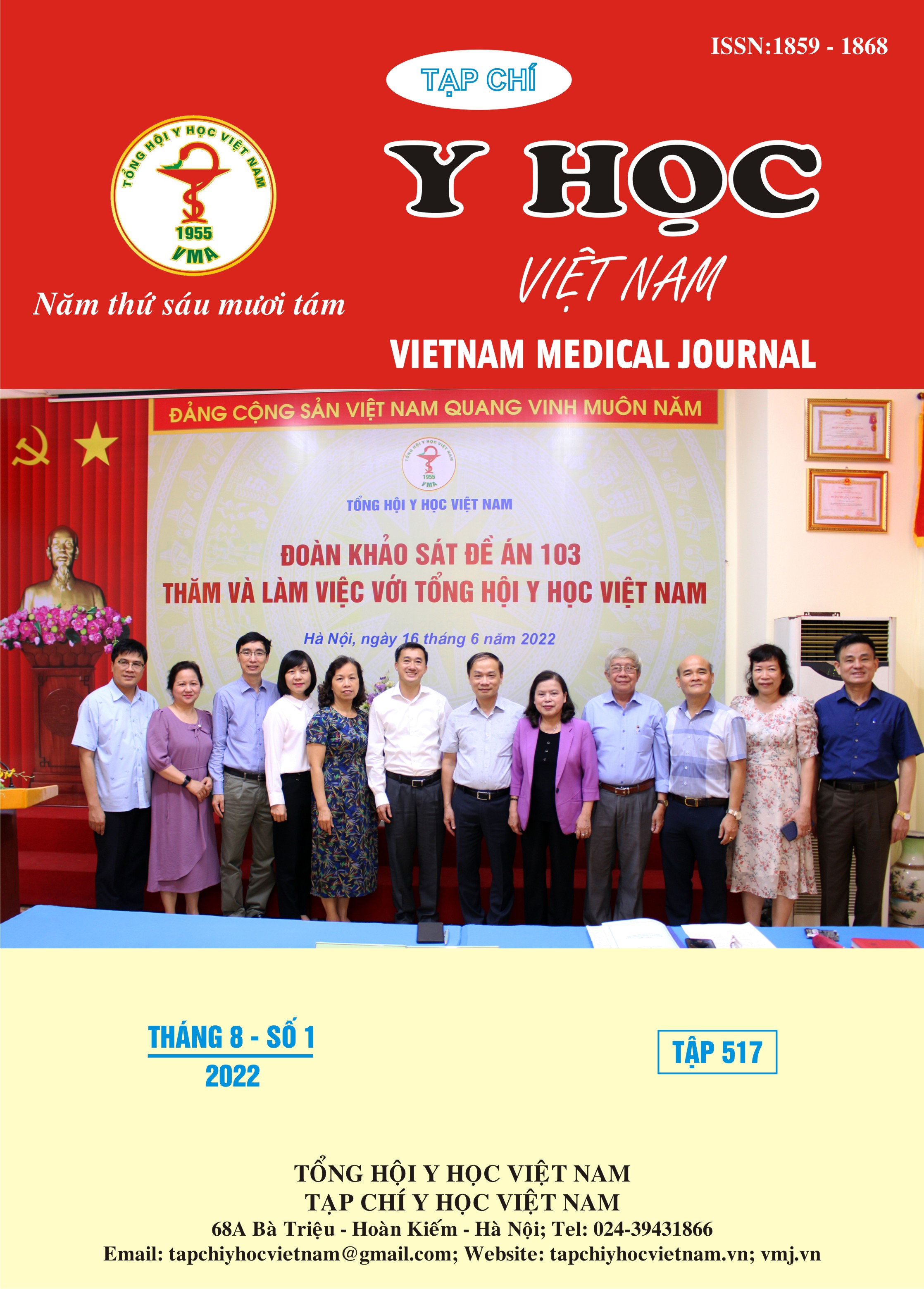KẾT QUẢ TẠO HÌNH TỨC THÌ PHỨC HỢP XƯƠNG HÀM DƯỚI BẰNG VẠT DA XƯƠNG MÁC SAU PHẪU THUẬT ĐIỀU TRỊ UNG THƯ
Nội dung chính của bài viết
Tóm tắt
Mục tiêu: Đánh giá kết quả tạo hình tức thì trên các bệnh nhân với tổn thương phức hợp vùng miệng-hàm dưới bằng vạt da xương mác sau phẫu thuật điều trị ung thư. Phương pháp nghiên cứu: Nghiên cứu được tiến hành trên 63 bệnh nhân được chẩn đoán là ung thư vùng hàm mặt được phẫu thuật cắt bỏ phức hợp xương hàm dưới tại Khoa Phẫu thuật Tạo hình Thẩm mỹ, Bệnh viện Răng hàm mặt Trung ương Hà Nội từ tháng 5/2014 đến tháng 7/2021. Kết quả: Tuổi trung bình của bệnh nhân là 54.05 ± 13.14, tỉ lệ nam/nữ = 2/1. Các vạt xương mác có đảo da với chiều rộng trung bình là 5.79 ± 0.60 cm và chiều dài trung bình là 14.46 ± 1.33, trong đó 62/63 đảo da của vạt được sử dụng để che phủ khuyết hổng niêm mạc miệng, và 1 trường hợp được sử dụng để che phủ khuyết da. Số đoạn xương mác được sử dụng để tạo hình theo đoạn xương hàm dưới khuyết hổng trung bình là 2.44 ± 0.79 đoạn. Kết quả có 2/63 trường hợp hoại tử hoàn toàn vạt da xương mác và không có trường hợp nào hoại tử một phần vạt. Tổng cộng có 40 biến chứng trên 29 bệnh nhân khác nhau. Thời gian theo dõi sau mổ trung bình là 40.24 ± 21.25 tháng, có 50 bệnh nhân còn sống và 13 bệnh nhân đã tử vong (thời gian sống trung bình là 23.92 ± 19.45 tháng). Kết quả phục hồi chức năng ăn nhai, nói, và há miệng tương đối tốt, với tỉ lệ bệnh nhân đạt mức độ bình thường hoặc chỉ rối loạn nhẹ tương ứng là 84.5%, 82.8%, và 98.3%. Có 41.4% đạt kết quả thẩm mỹ rất tốt, 50.0% đạt kết quả tốt, và còn lại là 8.6% đạt kết quả trung bình. Kết luận: Phẫu thuật tạo hình tức thì khuyết hổng phức hợp vùng miệng-hàm dưới bằng vạt da xương mác sau phẫu thuật điều trị ung thư cho các kết quả về chức năng và thẩm mỹ rất khả quan, nên được thực hiện một cách thường quy để đảm bảo chất lượng cuộc sống tối đa cho bệnh nhân.
Chi tiết bài viết
Từ khóa
composite oromandibular defect, osteocutaneous fibular flap, cancer resection
Tài liệu tham khảo
2. S. Sharma and S. Bera, “Oromandibular reconstruction with free fibula osteocutaneous flap after oncologic resection: retrospective analysis of surgical experience and operative outcome of 56 cases,” International Surgery Journal, vol. 6, p. 3674, Sep. 2019, doi: 10.18203/2349-2902. isj20194423.
3. Nguyễn Quang Đức, “Nghiên cứu sử dụng vạt xương mác tự do có nối mạch nuôi trong tạo hình mất đoạn lớn xương hàm dưới,” Luận án tiến sĩ Y học, Viện nghiên cứu khoa học y dược lâm sàng 108, 2011.
4. S. M. Fu-Chan Wei MD, Flaps and Reconstructive Surgery, 2nd edition. Elsevier, 2016.
5. J. M. López-Arcas et al., “The fibula osteomyocutaneous flap for mandible reconstruction: a 15-year experience,” J Oral Maxillofac Surg, vol. 68, no. 10, pp. 2377–2384, Oct. 2010, doi: 10.1016/j.joms.2009.09.027.
6. T. A. Zrnc et al., “Complex Mandibular Reconstruction for Head and Neck Squamous Cell Carcinoma-The Ongoing Challenge in Reconstruction and Rehabilitation,” Cancers (Basel), vol. 12, no. 11, Art. no. 11, Oct. 2020, doi: 10.3390/cancers12113198.
7. J. N. Lodders et al., “Incidence and types of complications after ablative oral cancer surgery with primary microvascular free flap reconstruction,” Med Oral Patol Oral Cir Bucal, vol. 20, no. 6, pp. e744-750, Nov. 2015, doi: 10.4317/medoral.20657.
8. O. Camuzard et al., “Primary radical ablative surgery and fibula free-flap reconstruction for T4 oral cavity squamous cell carcinoma with mandibular invasion: oncologic and functional results and their predictive factors,” Eur Arch Otorhinolaryngol, vol. 274, no. 1, Art. no. 1, Jan. 2017, doi: 10.1007/s00405-016-4219-7.


